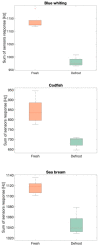A Multi-Sensor System for Sea Water Iodide Monitoring and Seafood Quality Assurance: Proof-of-Concept Study
- PMID: 34209984
- PMCID: PMC8271796
- DOI: 10.3390/s21134464
A Multi-Sensor System for Sea Water Iodide Monitoring and Seafood Quality Assurance: Proof-of-Concept Study
Abstract
Iodine is a trace chemical element fundamental for a healthy human organism. Iodine deficiency affects about 2 billion people worldwide causing from mild to severe neurological impairment, especially in children. Nevertheless, an adequate nutritional intake is considered the best approach to prevent such disorders. Iodine is present in seawater and seafood, and its common forms in the diet are iodide and iodate; most iodide in seawater is caused by the biological reduction of the thermodynamically stable iodate species. On this basis, a multisensor instrument which is able to perform a multidimensional assessment, evaluating iodide content in seawater and seafood (via an electrochemical sensor) and discriminating when the seafood is fresh or defrosted quality (via a Quartz Micro balance (QMB)-based volatile and gas sensor), is strategic for seafood quality assurance. Moreover, an electronic interface has been opportunely designed and simulated for a low-power portable release of the device, which should be able to identify seafood over or under an iodide threshold previously selected. The electrochemical sensor has been successfully calibrated in the range 10-640 μg/L, obtaining a root mean square error in cross validation (RMSECV) of only 1.6 μg/L. Fresh and defrosted samples of cod, sea bream and blue whiting fish have been correctly discriminated. This proof-of-concept work has demonstrated the feasibility of the proposed application which must be replicated in a real scenario.
Keywords: electrochemical sensors; gas sensors; iodide; iodine; sea water; seafood quality.
Conflict of interest statement
The authors declare no conflict of interest.
Figures










References
MeSH terms
Substances
LinkOut - more resources
Full Text Sources

